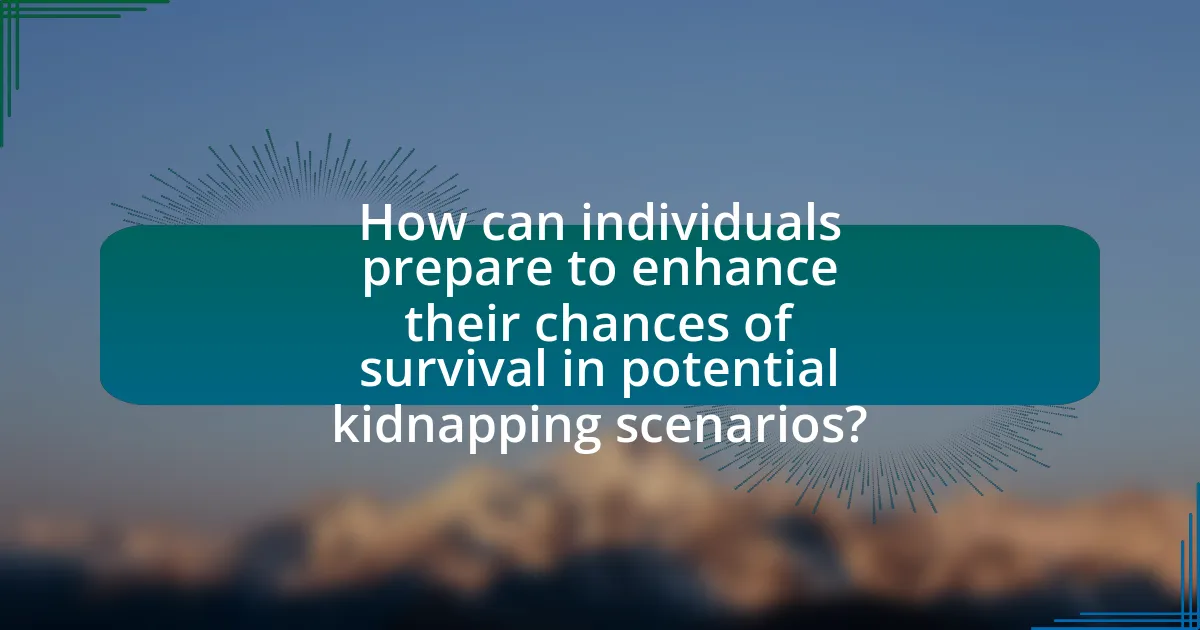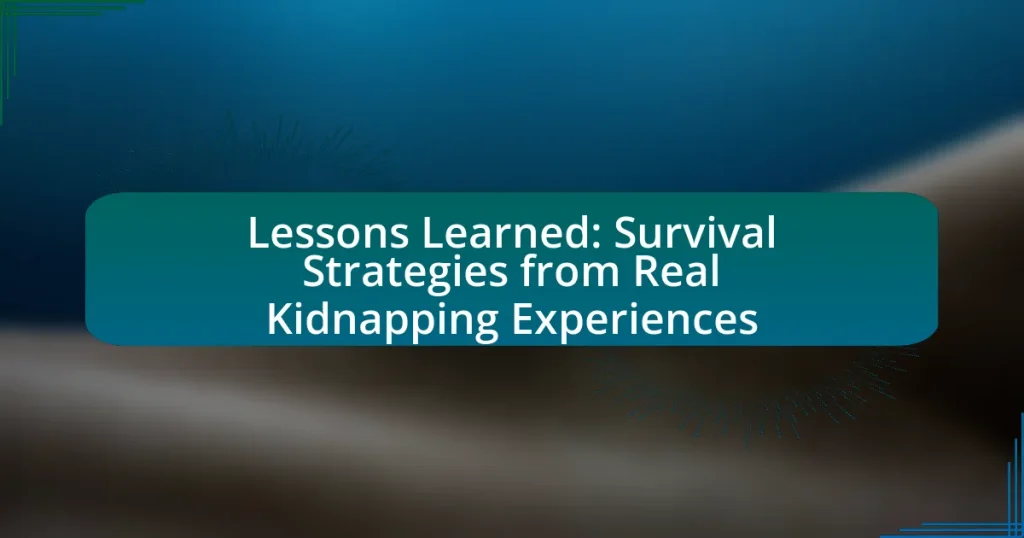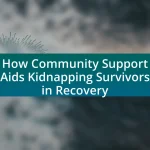The article “Lessons Learned: Survival Strategies from Real Kidnapping Experiences” examines critical insights gained from actual kidnapping cases, emphasizing the importance of remaining calm, establishing rapport with captors, and maintaining situational awareness for survival. It discusses the psychological effects of kidnapping on victims, including PTSD and anxiety, and highlights how different environments influence survival strategies. The article also outlines effective communication techniques with captors, mental resilience, and physical preparedness as vital components for enhancing survival chances. Additionally, it provides practical tips for individuals to prepare for potential kidnapping scenarios, including situational awareness and self-defense training, while underscoring the role of community initiatives in preventing abductions.

What are the key lessons learned from real kidnapping experiences?
Key lessons learned from real kidnapping experiences include the importance of remaining calm, establishing rapport with the captor, and being aware of surroundings. Remaining calm helps individuals think clearly and make rational decisions, which can be crucial for survival. Establishing rapport can lead to more favorable treatment and potentially increase the chances of release, as evidenced by cases where captives who engaged positively with their captors were treated better. Awareness of surroundings allows individuals to identify escape opportunities or gather information that could aid in their rescue. These strategies have been supported by various accounts from survivors and studies on hostage situations, highlighting their effectiveness in enhancing survival outcomes.
How do survivors describe their experiences during a kidnapping?
Survivors describe their experiences during a kidnapping as traumatic and disorienting, often highlighting feelings of fear, helplessness, and anxiety. Many report that the initial moments are marked by shock and disbelief, followed by a struggle to maintain composure and think strategically about their survival. Research indicates that survivors frequently emphasize the importance of mental resilience and the ability to remain calm under pressure, which can significantly influence their chances of escape or survival. For instance, a study published in the Journal of Traumatic Stress found that survivors who employed coping strategies, such as focusing on their breathing and assessing their surroundings, reported better outcomes.
What psychological effects do kidnappings have on victims?
Kidnappings have significant psychological effects on victims, including post-traumatic stress disorder (PTSD), anxiety, depression, and feelings of helplessness. Research indicates that approximately 30% of kidnapping victims develop PTSD, characterized by flashbacks, severe anxiety, and uncontrollable thoughts about the traumatic event. Victims often experience heightened levels of fear and hyper-vigilance, which can persist long after the ordeal. Additionally, many victims report difficulties in social reintegration, leading to isolation and strained relationships. These psychological impacts are supported by studies, such as one published in the Journal of Traumatic Stress, which highlights the long-term mental health challenges faced by individuals who have experienced kidnapping.
How do different environments influence the survival strategies of victims?
Different environments significantly influence the survival strategies of victims by dictating available resources, social dynamics, and potential escape routes. For instance, urban environments often provide more opportunities for interaction with bystanders or law enforcement, which can enhance a victim’s chances of rescue. In contrast, rural settings may limit immediate help but offer natural cover for evasion. Research indicates that victims in isolated areas may rely more on stealth and camouflage, while those in populated regions might utilize communication and signaling to attract attention. A study by the National Institute of Justice highlights that environmental factors, such as population density and accessibility, directly impact the effectiveness of survival tactics employed by victims during abduction scenarios.
What common survival strategies have emerged from these experiences?
Common survival strategies that have emerged from real kidnapping experiences include maintaining calmness, establishing rapport with captors, and utilizing situational awareness. Maintaining calmness helps victims think clearly and make rational decisions, which is crucial for survival. Establishing rapport with captors can lead to more favorable treatment and potential opportunities for escape, as seen in various documented cases where victims formed connections with their abductors. Additionally, situational awareness allows victims to assess their environment and identify potential escape routes or resources, enhancing their chances of survival. These strategies are supported by numerous accounts from survivors who have successfully navigated their abduction experiences.
What role does mental resilience play in survival?
Mental resilience is crucial for survival as it enables individuals to cope with stress, adapt to challenging situations, and maintain a positive outlook during crises. In high-stress scenarios, such as kidnapping, mental resilience helps individuals manage fear and anxiety, allowing them to think clearly and make strategic decisions. Research indicates that resilient individuals are more likely to employ effective coping strategies, which can significantly enhance their chances of survival. For example, a study published in the Journal of Traumatic Stress found that individuals with higher levels of resilience reported better psychological outcomes and were more adept at navigating traumatic experiences. This demonstrates that mental resilience not only aids in emotional regulation but also plays a vital role in the practical aspects of survival.
How can physical preparedness impact a victim’s chances of survival?
Physical preparedness significantly enhances a victim’s chances of survival during a kidnapping situation. Victims who maintain good physical fitness can exhibit greater endurance, strength, and agility, which are crucial for escaping or resisting captors. Research indicates that individuals with higher physical fitness levels are better equipped to handle stress and physical challenges, increasing their likelihood of survival in life-threatening situations. For instance, a study published in the Journal of Applied Physiology found that physical fitness improves cardiovascular health and stress resilience, both of which are vital during high-pressure scenarios like kidnappings.

What specific strategies can be employed during a kidnapping situation?
During a kidnapping situation, specific strategies include remaining calm, assessing the environment, and complying with the captor’s demands to increase chances of survival. Remaining calm helps maintain clarity and rational thinking, which is crucial for making informed decisions. Assessing the environment allows the victim to identify potential escape routes or resources that could aid in their situation. Complying with demands can reduce the likelihood of violence, as many kidnappers seek compliance rather than confrontation. Historical data indicates that victims who exhibit cooperation often experience less aggressive behavior from their captors, thereby enhancing their chances of survival.
How can victims effectively communicate with their captors?
Victims can effectively communicate with their captors by establishing a rapport and using calm, non-threatening language. Building rapport can involve finding common ground or showing empathy, which may lead to a more favorable interaction. Research indicates that victims who engage in active listening and demonstrate understanding can influence their captors’ behavior positively, potentially increasing their chances of survival. For instance, studies on hostage situations reveal that victims who maintain a composed demeanor and express concern for their captors’ feelings often experience less aggression and more leniency.
What techniques can help in building rapport with captors?
Building rapport with captors can be achieved through techniques such as active listening, mirroring behavior, and finding common ground. Active listening involves attentively acknowledging the captor’s words and emotions, which fosters a sense of respect and understanding. Mirroring behavior, such as adopting similar body language or speech patterns, can create a subconscious bond, making the captor feel more comfortable. Finding common ground, whether through shared interests or experiences, can also enhance the connection, as it humanizes the interaction and reduces perceived threats. These techniques are supported by psychological principles that emphasize the importance of empathy and connection in interpersonal relationships.
How can victims assess their captors’ behavior for potential escape opportunities?
Victims can assess their captors’ behavior for potential escape opportunities by observing patterns in their routines, emotional states, and interactions with others. Captors may exhibit predictable behaviors, such as times of increased distraction or reduced vigilance, which can signal a window for escape. For instance, if a captor frequently leaves the area during specific times or becomes less attentive during certain activities, victims can use these moments to plan their escape. Research indicates that understanding psychological cues, such as a captor’s frustration or fatigue, can also provide insights into when they may be less likely to respond aggressively, thereby increasing the chances of a successful escape.
What actions should victims take immediately after being kidnapped?
Victims should remain calm and assess their situation immediately after being kidnapped. Staying composed allows victims to think clearly and evaluate their surroundings, which is crucial for formulating an escape plan or identifying potential opportunities for assistance. Research indicates that maintaining a level head can significantly increase the chances of survival and successful escape in kidnapping scenarios. For instance, a study published in the Journal of Interpersonal Violence highlights that victims who actively engage in problem-solving during captivity tend to have better outcomes.
How can victims use their surroundings to their advantage?
Victims can use their surroundings to their advantage by identifying escape routes, utilizing objects for self-defense, and attracting attention for help. For instance, recognizing exits or potential hiding spots can facilitate a timely escape during a kidnapping scenario. Additionally, everyday items like keys or pens can serve as improvised weapons to fend off an attacker. Furthermore, making noise or using reflective surfaces to signal for help can draw attention from passersby, increasing the chances of rescue. These strategies are supported by real-life accounts where victims successfully navigated their environments to enhance their safety and survival.
What mental strategies can help maintain hope and focus during captivity?
Mental strategies that can help maintain hope and focus during captivity include visualization, positive self-talk, and establishing a routine. Visualization allows individuals to mentally escape their situation by imagining a safe place or future freedom, which can foster hope. Positive self-talk reinforces resilience by encouraging individuals to focus on their strengths and capabilities, countering feelings of despair. Establishing a routine provides a sense of normalcy and control, helping to maintain mental clarity and focus on survival. These strategies have been observed in various survival scenarios, such as the experiences of hostages who utilized mental techniques to cope with their circumstances, demonstrating their effectiveness in maintaining psychological well-being during captivity.

How can individuals prepare to enhance their chances of survival in potential kidnapping scenarios?
Individuals can enhance their chances of survival in potential kidnapping scenarios by developing situational awareness and practicing self-defense techniques. Situational awareness involves being conscious of one’s surroundings, recognizing potential threats, and avoiding risky situations, which can significantly reduce the likelihood of abduction. For instance, studies show that individuals who remain alert and avoid distractions, such as mobile devices, are less likely to become targets. Additionally, learning self-defense can empower individuals to respond effectively if confronted by an attacker, as evidenced by research indicating that self-defense training increases confidence and the ability to escape dangerous situations.
What preventative measures can be taken to avoid kidnapping?
To avoid kidnapping, individuals should adopt several preventative measures, including maintaining situational awareness, establishing safe routines, and utilizing technology for safety. Situational awareness involves being conscious of one’s surroundings and recognizing potential threats, which can significantly reduce vulnerability. Establishing safe routines, such as varying travel routes and times, can make it harder for potential kidnappers to predict movements. Additionally, utilizing technology, such as GPS tracking apps and emergency alert systems, can provide an extra layer of security. According to the FBI, awareness and preparation are key factors in preventing abduction, as they empower individuals to respond effectively to potential dangers.
How can awareness of surroundings reduce the risk of abduction?
Awareness of surroundings significantly reduces the risk of abduction by enabling individuals to identify potential threats and avoid dangerous situations. When people remain vigilant, they can recognize suspicious behavior, unusual circumstances, or individuals who may pose a risk, allowing them to take proactive measures such as changing their route or seeking help. Research indicates that 70% of abductions involve a degree of premeditation, meaning that perpetrators often observe their targets before acting. By being aware, individuals can disrupt this observation phase, making themselves less appealing targets.
What self-defense techniques are most effective in preventing kidnapping?
Effective self-defense techniques for preventing kidnapping include situational awareness, verbal de-escalation, and physical self-defense maneuvers. Situational awareness involves being alert to one’s surroundings and recognizing potential threats, which can help individuals avoid dangerous situations before they escalate. Verbal de-escalation techniques, such as assertively communicating boundaries or seeking help from bystanders, can deter potential kidnappers. Physical self-defense maneuvers, like targeting vulnerable areas (eyes, throat, groin), can incapacitate an attacker long enough to escape. Research indicates that individuals trained in self-defense are more likely to successfully fend off attackers, as evidenced by a study published in the Journal of Interpersonal Violence, which found that self-defense training significantly increases confidence and reduces the likelihood of victimization.
What resources are available for education on kidnapping survival strategies?
Resources available for education on kidnapping survival strategies include books, online courses, and workshops. Notable books such as “Surviving a Kidnapping” by Michael J. McGowan provide practical advice based on real-life experiences. Online platforms like Udemy and Coursera offer courses focused on personal safety and survival tactics, often developed by experts in security and law enforcement. Additionally, organizations such as the National Center for Missing & Exploited Children provide educational materials and resources aimed at preventing abduction and enhancing survival skills. These resources are validated by their use in training programs and their endorsement by professionals in the field of personal safety and security.
How can training programs improve personal safety awareness?
Training programs can significantly improve personal safety awareness by providing individuals with essential skills and knowledge to recognize and respond to potential threats. These programs often include practical scenarios, role-playing, and situational awareness training, which enhance participants’ ability to identify risky situations and make informed decisions. Research indicates that individuals who undergo safety training are more likely to employ preventive measures and exhibit heightened vigilance in their daily lives, leading to a reduction in victimization rates. For example, a study published in the Journal of Safety Research found that participants in personal safety workshops reported a 30% increase in their ability to recognize dangerous situations compared to those who did not receive such training.
What role do community initiatives play in preventing kidnappings?
Community initiatives play a crucial role in preventing kidnappings by fostering awareness, vigilance, and cooperation among residents. These initiatives often involve neighborhood watch programs, community education on safety practices, and collaboration with local law enforcement, which collectively enhance the ability to identify and respond to suspicious activities. For instance, studies have shown that areas with active community engagement report lower crime rates, including kidnappings, due to increased surveillance and communication among residents. Additionally, community-led workshops that educate families about safety measures and emergency protocols empower individuals to take proactive steps in protecting themselves and their children, further contributing to a safer environment.
What practical tips can individuals implement to prepare for potential kidnapping situations?
To prepare for potential kidnapping situations, individuals should develop situational awareness, establish a safety plan, and practice self-defense techniques. Situational awareness involves being conscious of one’s surroundings and recognizing potential threats, which can significantly reduce the risk of abduction. Establishing a safety plan includes identifying safe locations, trusted contacts, and escape routes, ensuring that individuals know what to do in case of an emergency. Practicing self-defense techniques empowers individuals to respond effectively if confronted by an attacker, increasing their chances of escaping. According to the FBI, awareness and preparation are key factors in preventing kidnapping incidents, as proactive measures can deter potential abductors.


